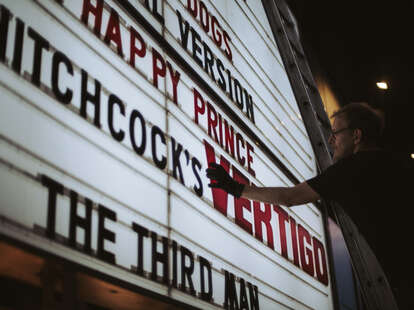
Tap Into Vienna’s Cinematic History with a Visit to Burg Kino
This retro gem’s weekly screenings of “The Third Man” have been drawing locals and tourists alike for decades.
There’s nothing quite like going to a movie theater in a foreign country. The setting is familiar—framed film posters, plush red seats, old-fashioned concession stands—until you find out that those self-serve “butter” machines don’t exist outside of the States, and you start to hear murmurings of “Is this seat taken?” in another language. But all these minor differences get put aside once the room goes black. You and your fellow viewers go where the film goes, and if you’re lucky, it might even capture the very place you’ve come to visit.
At Vienna’s Burg Kino, that film is likely to be The Third Man, a 1949 black-and-white thriller set in postwar Vienna. When former manager Kurt Schramek decided to put it on the big screen back in the 1980s, what began as a simple reprise turned into a long-standing tradition, as locals and tourists alike continued to request it at the box office.
Directed by Carol Reed, the British film noir staple follows pulp novelist Holly Martins as he travels to a war-torn Vienna and discovers that his old pal, Harry Lime—played by the legendary Orson Welles—is dead. On screen, Reed’s Vienna is home to a thriving black market that runs rampant through the Russian, British, French, and American zones borne from the aftermath of World War II. From the beginning, the depiction captivated English-speaking audiences, and in 1999, the British Film Institute voted The Third Man the greatest British film of all time.
“Vienna is a city that has always characterized itself as leaning towards a morbid, darker culture,” says Stefan Schramek, Kurt’s son and the current manager at Burg Kino. “This movie captures a certain essence of the city, a document of a time that would otherwise be lost.”
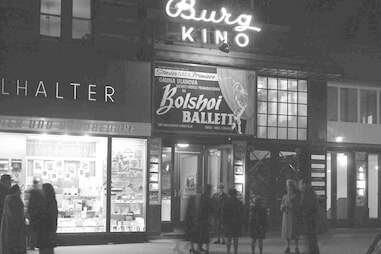
And while the cult classic is certainly a major draw, the neon-lit Burg Kino has a lot more going for it—namely, its dedication to projecting movies in their original, undoctored states. Founded in 1912 along the city’s famous Ringstrasse, Burg Kino is one of the oldest still-operating cinemas in the world, remaining charmingly vintage and full of history.
“Until the late '70s, it was the only cinema in Austria—and also in Germany—that showed films in their original versions,” says Schramek, who believes dubbed movies “lose some of their spirit.” Since the era of silent films, Burg Kino has premiered works from famous filmmakers like Charlie Chaplin and Buster Keaton, and was one of the first theaters in Austria to make the transition to sound.
The theater, one of the first concrete facades built on the Ringstrasse, is illuminated by a plain-and-simple red marquee. It was a one-screen theater until 1986, after which a second, smaller screen was built. Upon entering, a staircase will lead you down to a cash-only ticket counter, and from there you’ll make your way to a concession area that resembles a Viennese cafe, replete with Manner wafers and bentwood chairs. The Third Man is often screened in the main theater, or Großer Saal, which boasts balcony seating and plenty of old-Hollywood vibes.

Throughout its long reign, Burg Kino has predictably faced some tumultuous times. When the groundbreaking Soviet propaganda film Battleship Potemkin premiered at the theater in the mid-1920s, it was met with uproar from National Socialists, and ultimately, violence inside the cinema hall. In the years between the World Wars, screening foreign films became increasingly difficult, as the cinema became Aryanized (a.k.a. handed over to non-Jews). Following the fall of Nazi Germany, Burg Kino was returned to its original owners. Soon after, the cinema made a name for itself with the premiere of Italian director Federico Fellini’s 1954 drama La Strada (it helped that future German media mogul Leo Kirch had recently bought the film’s rights).
When Schramek’s father took over in the 1980s, he was tasked with establishing Burg Kino, which had always been a privately owned theater. It was hard to get licenses to screen new movies at the time, as a publicly owned cinema conglomerate held most of the power over Vienna’s movie-going public. So Kurt decided to turn to the older stuff—a move that ultimately set his theater apart from the pack.
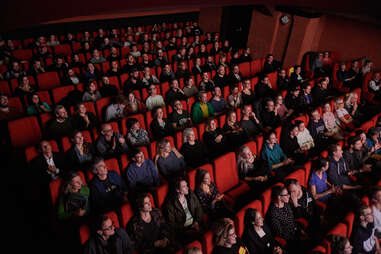
The resulting success wasn’t wholly unexpected. After all, Kurt, a tested cinephile, was chosen as the business’s successor for his extensive knowledge of film history. Growing up in southern Austria, he’d spend his time visiting other cities just to see movies, sometimes sneaking into those he was a little too young for. And while he went to university to pursue mathematics, he was much more passionate about organizing film festivals for his classmates on the side.
But in the early 2000s, things started to change again. Burg Kino had been able to gain access to new film rights in the mid-80s. But the practice of downloading movies online started to take hold and large, flashy multiplexes began to emerge. In just a few years, the theater lost nearly half of its clientele. “It was really almost the end of Burg Kino,” Schramek says. “Lots of cinemas closed around those years, all around the world, but especially in Vienna, which was, at that time, the city in Europe with the most cinema seats per inhabitant.”
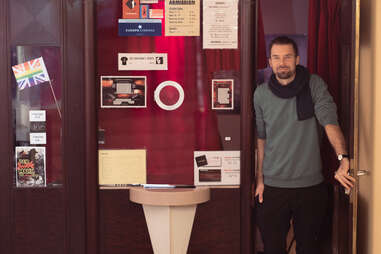
Thankfully, as the 2000s came to a close, moviegoers resumed their appreciation for smaller, independent cinemas around the same time vinyl records experienced a resurgence. Today, Schramek’s theater is devoted to showcasing quality films from around the world. And while they’re still staunchly against dubbing, in recent years they’ve begun to incorporate films with English subtitles instead of German ones, a nod to the many non-German-speaking tourists looking to punch their ticket to a show.
Speaking of foreign visitors, Burg Kino is no stranger to welcoming all sorts of out-of-towners—even some famous ones. Over the years, it’s hosted directors like Olivier Assayas, Robert Guedigian, and Jon Amiel, and has been the site of events like the Vienna Shorts Film Festival and Jewish Film Festival, as well as regular panel discussions. Schramek even recalls a time when Bill Murray stopped by, picking up a Third Man T-shirt on his way out.
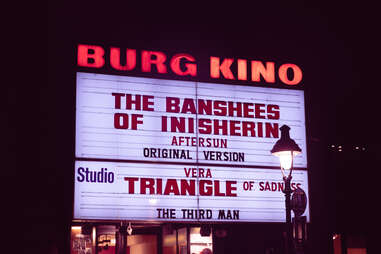
A screening of The Third Man at Burg Kino is recommended in a number of guidebooks, a low-key, rainy-day activity that stands in contrast to the city’s more grandiose offerings. But the film is a guidebook in itself, granting notoriety to a handful of Viennese sites. Schramek mentions a few tours you can book to take you around such filming locales, the most famous of which include the Riesenrad ferris wheel at Prater Park, the setting for one of the film’s most important confrontations, as well as the underground “cholera canals,” where a certain character attempts to flee. You can even pay a visit to the nearby Third Man Museum, which houses over 3,000 original artifacts from the film.
Whether you come to Burg Kino to see The Third Man or a more recent flick, know that you’re watching a story unfold in a building marked by cinematic history, surrounded by a city known for its artistry. For Schramek, there’s beauty in watching the place you’re traveling to on the big screen, but there’s something comforting about getting a little lost, too.
“[Going to a movie] connects you to a non-local, continuous space of arts that gets you out of where you are at the moment,” Schramek says. “So if you're in another city, you can still go to a place you kind of know.”